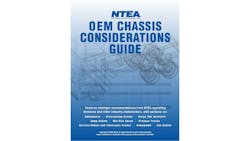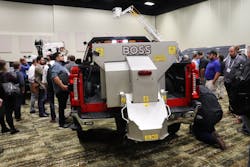SANDUSKY, Ohio—NTEA released the first edition of its OEM Chassis Considerations Guide during NTEA’s Commercial Vehicle Upfitting Summit here in October.
The guide is designed to help inform OEM product development communities of the work truck industry’s needs from their chassis products, both now and into the future.
“NTEA’s Chassis Considerations Guide serves as an important tool for OEMs and anyone designing truck-mounted equipment to use during their product development process,” said Steve Spata, NTEA senior technical assistance director. “This comprehensive guidebook comes at a pivotal time—as vehicles become increasingly complex—and helps support chassis product development for a broad array of commercial vehicle applications. Building on the history and success of NTEA’s Chassis Design Considerations for the Service Body Industry, this guide captures valuable truck body and vehicle upfitter perspectives and industry knowledge.”
Indeed, not only are vehicles more complex, but generational shifts in the industry have only widened the “knowledge gap” between chassis suppliers and truck equipment manufacturers, as Spata explained to TBB.
Read more: Work Truck Week 2024 schedule released, registration open
“OEMs have been losing a lot of experience, like everybody else,” Spata said. “This is a tool for the industry to capture what these communities of manufacturers—who build these different vocational vehicles—have said: ‘this is what we want out of a chassis, today and into the future.’”
And, as chassis builders have learned the hard way over the years, not understanding how their products are used in the vocational space can mean expensive design changes or, worse, lost business as body builders and upfitters look for a platform better suited to the application and equipment, he explained.
Of course, a chassis can’t be all things to all vocational operations, so well-thought-out designs and flexibility should be the goal.
“For the OEM, it’s a benefit if I can make one chassis with different features work for a number of different vocational missions,” Spata said. “For the upfitters, now I have the features and things I can use: I don’t have to hack into the wiring, I have clear space where I need it for this particular upfit. That makes it easier, makes it cost less, makes it much more smooth. And it gets the user, the fleet customer, the right vehicle.”
Topics covered
The OEM Chassis Considerations Guide discusses:
- Chassis features and functions
- Electrical needs
- Regulatory and safety considerations
- Vocational market and design challenges
Provided from the perspective of vocational body and equipment manufacturers and upfitters, this guide offers strategic recommendations and considerations for key industry segments. Sections address:
- Ambulances
- Articulating cranes
- Cargo van interiors
- Dump bodies
- Mid-size buses
- Propane trucks
- Service bodies and telescopic cranes
- Snowplows
- Van bodies
The OEM Chassis Considerations Guide is available free to NTEA members. Visit ntea.com/chassisguide, or contact NTEA at [email protected] or 800-441-6832, for additional details and report access.
About the Author
John Hitch
Editor-in-chief, Fleet Maintenance, Senior Editor, Trailer-Body Builders
John Hitch is the editor-in-chief of Fleet Maintenance, where his mission is to provide maintenance management and technicians with the the latest information on the tools and strategies to keep their fleets' commercial vehicles moving.
He is based out of Cleveland, Ohio, and has worked in the B2B journalism space for more than a decade.
Hitch was previously senior editor for FleetOwner, and covers everything related to trucking and commercial vehicle equipment, including breaking news, the latest trends and best practices. He previously wrote about manufacturing and advanced technology for IndustryWeek and New Equipment Digest.
Prior to that he was editor for Kent State University's student magazine, The Burr, and a freelancer for Cleveland Magazine. He is an award-winning journalist and former sonar technician, where he served honorably aboard the fast-attack submarine USS Oklahoma City (SSN-723).



